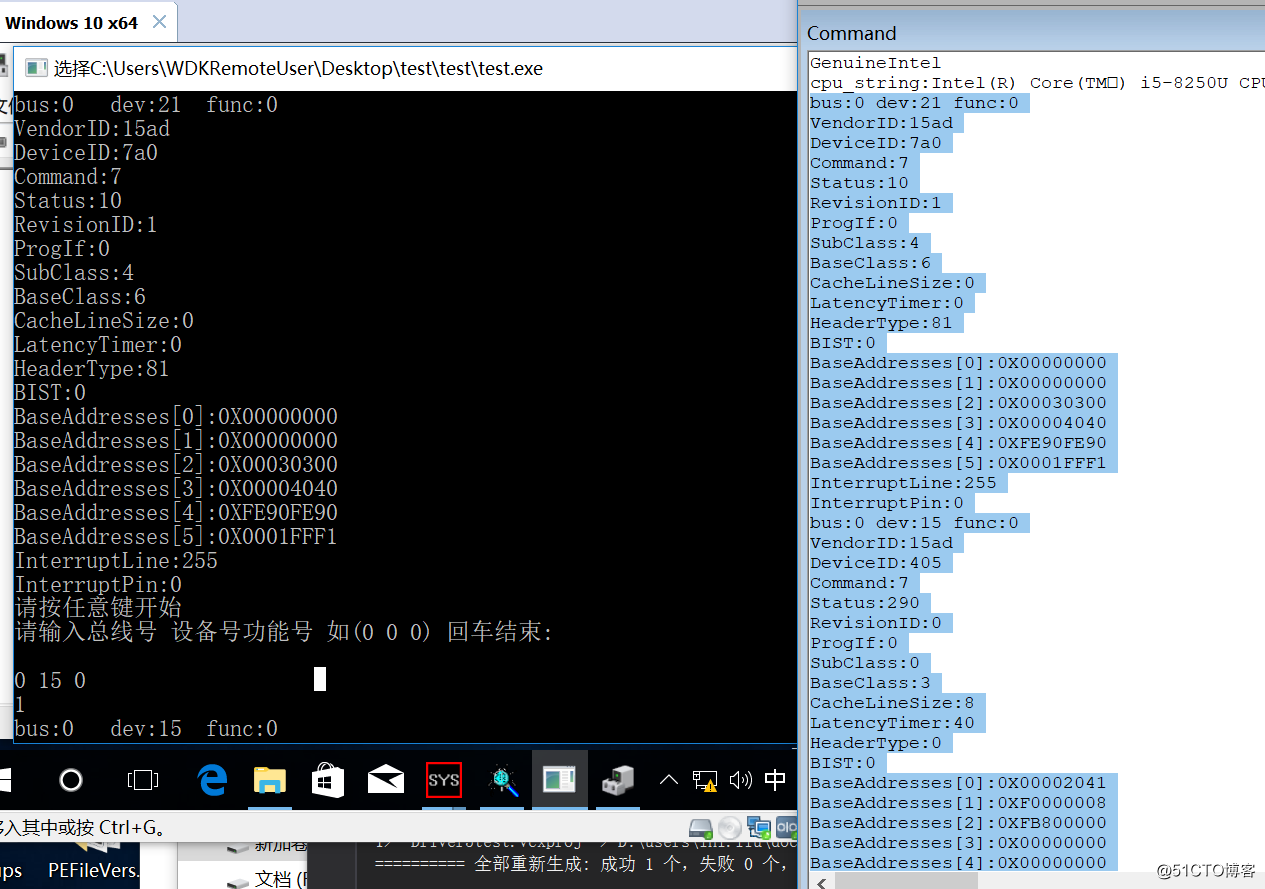wdmWin10下遍历PCI配置空间
2021-06-30 22:05
标签:include nio context tab ima c++ NPU mat 建设 图左边自己实现的用了俩种方式枚举pci //Driver.h wdmWin10下遍历PCI配置空间 标签:include nio context tab ima c++ NPU mat 建设 原文地址:http://blog.51cto.com/haidragon/2317816
图右边是引用驱动开发技术详解书中的代码:
3环只增加了个死循环 驱动没变
#include
一种是用api HalGetBusDataByOffset
一种上是修改书的代码
0环
entry.c#include "Driver.h"
NTSTATUS DriverEntry(
IN PDRIVER_OBJECT pDriverObject,
IN PUNICODE_STRING pRegistryPath)
{
NTSTATUS status;
//判断CPU类型
CPUType();
//枚举
EnumeratePCI();
//EnumPCI();
KdPrint(("Enter DriverEntry\n"));
//DbgBreakPoint();
//设置卸载函数
pDriverObject->DriverUnload =DDKUnload;
//设置派遣函数
pDriverObject->MajorFunction[IRP_MJ_CREATE] = DDKDispatchRoutin;
pDriverObject->MajorFunction[IRP_MJ_CLOSE] = DDKDispatchRoutin;
pDriverObject->MajorFunction[IRP_MJ_WRITE] = DDKDispatchRoutin;
pDriverObject->MajorFunction[IRP_MJ_READ] = DDKDispatchRoutin;
pDriverObject->MajorFunction[IRP_MJ_CLEANUP] = DDKDispatchRoutin;
pDriverObject->MajorFunction[IRP_MJ_DEVICE_CONTROL] = DDKDispatchRoutin;
pDriverObject->MajorFunction[IRP_MJ_SET_INFORMATION] = DDKDispatchRoutin;
pDriverObject->MajorFunction[IRP_MJ_SHUTDOWN] = DDKDispatchRoutin;
pDriverObject->MajorFunction[IRP_MJ_SYSTEM_CONTROL] = DDKDispatchRoutin;
//创建驱动设备对象
status = CreateDevice(pDriverObject);
KdPrint(("Leave DriverEntry\n"));
return status;
}
NTSTATUS CreateDevice(
IN PDRIVER_OBJECT pDriverObject)
{
NTSTATUS status;
PDEVICE_OBJECT pDevObj;
PDEVICE_EXTENSION pDevExt;
//创建设备名称
UNICODE_STRING devName;
RtlInitUnicodeString(&devName, L"\\Device\\MyDDKDevice");
//创建设备
status = IoCreateDevice(pDriverObject,
sizeof(DEVICE_EXTENSION),
&devName,
FILE_DEVICE_UNKNOWN,
0, TRUE,
&pDevObj);
if (!NT_SUCCESS(status))
return status;
pDevObj->Flags |= DO_BUFFERED_IO;
pDevExt = (PDEVICE_EXTENSION)pDevObj->DeviceExtension;
pDevExt->pDevice = pDevObj;
pDevExt->ustrDeviceName = devName;
//创建符号链接
UNICODE_STRING symLinkName;
RtlInitUnicodeString(&symLinkName, L"\\??\\TESTDDK");
pDevExt->ustrSymLinkName = symLinkName;
status = IoCreateSymbolicLink(&symLinkName, &devName);
if (!NT_SUCCESS(status))
{
IoDeleteDevice(pDevObj);
return status;
}
return STATUS_SUCCESS;
}
#pragma PAGEDCODE
VOID DDKUnload(IN PDRIVER_OBJECT pDriverObject)
{
PDEVICE_OBJECT pNextObj;
KdPrint(("Enter DriverUnload\n"));
pNextObj = pDriverObject->DeviceObject;
while (pNextObj != NULL)
{
PDEVICE_EXTENSION pDevExt = (PDEVICE_EXTENSION)
pNextObj->DeviceExtension;
//删除符号链接
UNICODE_STRING pLinkName = pDevExt->ustrSymLinkName;
IoDeleteSymbolicLink(&pLinkName);
pNextObj = pNextObj->NextDevice;
IoDeleteDevice(pDevExt->pDevice);
}
}
#pragma PAGEDCODE
NTSTATUS DDKDispatchRoutin(IN PDEVICE_OBJECT pDevObj,
IN PIRP pIrp)
{
KdPrint(("Enter HelloDDKDispatchRoutin\n"));
PIO_STACK_LOCATION stack = IoGetCurrentIrpStackLocation(pIrp);
//建立一个字符串数组与IRP类型对应起来
static char* irpname[] =
{
"IRP_MJ_CREATE",
"IRP_MJ_CREATE_NAMED_PIPE",
"IRP_MJ_CLOSE",
"IRP_MJ_READ",
"IRP_MJ_WRITE",
"IRP_MJ_QUERY_INFORMATION",
"IRP_MJ_SET_INFORMATION",
"IRP_MJ_QUERY_EA",
"IRP_MJ_SET_EA",
"IRP_MJ_FLUSH_BUFFERS",
"IRP_MJ_QUERY_VOLUME_INFORMATION",
"IRP_MJ_SET_VOLUME_INFORMATION",
"IRP_MJ_DIRECTORY_CONTROL",
"IRP_MJ_FILE_SYSTEM_CONTROL",
"IRP_MJ_DEVICE_CONTROL",
"IRP_MJ_INTERNAL_DEVICE_CONTROL",
"IRP_MJ_SHUTDOWN",
"IRP_MJ_LOCK_CONTROL",
"IRP_MJ_CLEANUP",
"IRP_MJ_CREATE_MAILSLOT",
"IRP_MJ_QUERY_SECURITY",
"IRP_MJ_SET_SECURITY",
"IRP_MJ_POWER",
"IRP_MJ_SYSTEM_CONTROL",
"IRP_MJ_DEVICE_CHANGE",
"IRP_MJ_QUERY_QUOTA",
"IRP_MJ_SET_QUOTA",
"IRP_MJ_PNP",
};
UCHAR type = stack->MajorFunction;
if (type >= arraysize(irpname))
KdPrint((" - Unknown IRP, major type %X\n", type));
else
KdPrint(("\t%s\n", irpname[type]));
//对一般IRP的简单操作,后面会介绍对IRP更复杂的操作
NTSTATUS status = STATUS_SUCCESS;
// 完成IRP
pIrp->IoStatus.Status = status;
pIrp->IoStatus.Information = 0; // bytes xfered
IoCompleteRequest(pIrp, IO_NO_INCREMENT);
KdPrint(("Leave DDKDispatchRoutin\n"));
return status;
}
stRet CPUType()
{
stRet st_Ret = {FALSE,FALSE};
ULONG CPUInfo[4] = { -1 };
CHAR cpu_string[48];
__cpuid(CPUInfo, 0);
INT num_ids = CPUInfo[0];
//GenuineIntel是Intel的CPU
//0x47, 0x65, 0x6E, 0x75, 0x69, 0x6E, 0x65, 0x49, 0x6E, 0x74, 0x65, 0x6C, 0x00, 0x00, 0x00, 0x00 GenuineIntel
if ((CPUInfo[1] == 0x756e6547) && (CPUInfo[2] == 0x6c65746e) && (CPUInfo[3] == 0x49656e69))
{
st_Ret.bIntelCPU=TRUE;
KdPrint(("GenuineIntel\n"));
}
//AuthenticAMD 是AMD的CPU
//0x41, 0x75, 0x74, 0x68, 0x65, 0x6E, 0x74, 0x69, 0x63, 0x41, 0x4D, 0x44, 0x00, 0x00, 0x00, 0x00 AuthenticAMD
if ((CPUInfo[1] == 0x68747541) && (CPUInfo[2] == 0x444d4163) && (CPUInfo[3] == 0x69746e65))
{
st_Ret.bIntelCPU = TRUE;
KdPrint(("AuthenticAMD\n"));
}
INT cpu_info[4] = { -1 };
__cpuid(cpu_info, 0);
// Interpret CPU feature information.
if (num_ids > 0) {
int cpu_info7[4] = { 0 };
__cpuid(cpu_info, 1);
if (num_ids >= 7) {
__cpuid(cpu_info7, 7);
}
signature_ = cpu_info[0];
stepping_ = cpu_info[0] & 0xf;
model_ = ((cpu_info[0] >> 4) & 0xf) + ((cpu_info[0] >> 12) & 0xf0);
family_ = (cpu_info[0] >> 8) & 0xf;
type_ = (cpu_info[0] >> 12) & 0x3;
ext_model_ = (cpu_info[0] >> 16) & 0xf;
ext_family_ = (cpu_info[0] >> 20) & 0xff;
has_mmx_ = (cpu_info[3] & 0x00800000) != 0;
has_sse_ = (cpu_info[3] & 0x02000000) != 0;
has_sse2_ = (cpu_info[3] & 0x04000000) != 0;
has_sse3_ = (cpu_info[2] & 0x00000001) != 0;
has_ssse3_ = (cpu_info[2] & 0x00000200) != 0;
has_sse41_ = (cpu_info[2] & 0x00080000) != 0;
has_sse42_ = (cpu_info[2] & 0x00100000) != 0;
has_aesni_ = (cpu_info[2] & 0x02000000) != 0;
has_avx2_ = has_avx_ && (cpu_info7[1] & 0x00000020) != 0;
}
// Get the brand string of the cpu.
__cpuid(cpu_info, 0x80000000);
const int parameter_end = 0x80000004;
int max_parameter = cpu_info[0];
//CHAR temp[40] = { -1 };
if (cpu_info[0] >= parameter_end) {
PCHAR cpu_string_ptr = cpu_string;
for (int parameter = 0x80000002; parameter = parameter_containing_non_stop_time_stamp_counter) {
__cpuid(cpu_info, parameter_containing_non_stop_time_stamp_counter);
has_non_stop_time_stamp_counter_ = (cpu_info[3] & (1 dwVendorID = tgaConfigInfo.VendorID;
//pHardWareInfo->dwDeviceID = tgaConfigInfo.DeviceID;
//pHardWareInfo->wSubSystemID = tgaConfigInfo.u.type0.SubSystemID;
//pHardWareInfo->wSubVendorID = tgaConfigInfo.u.type0.SubVendorID;
//pHardWareInfo->wRevisionID = tgaConfigInfo.RevisionID;
//wcscat(pHardWareInfo->wsHardwareID, pwcHardwareId);
//InsertTailList(&g_DisPlayInfo.VideoList, &pHardWareInfo->Next);
//MsgLog(L"枚举PCI成功");
break;
}
}
}
}
if (NULL != pwcHardwareId)
{
ExFreePool(pwcHardwareId);
pwcHardwareId = NULL;
}
} while (FALSE);
}#include
文章标题:wdmWin10下遍历PCI配置空间
文章链接:http://soscw.com/index.php/essay/100027.html